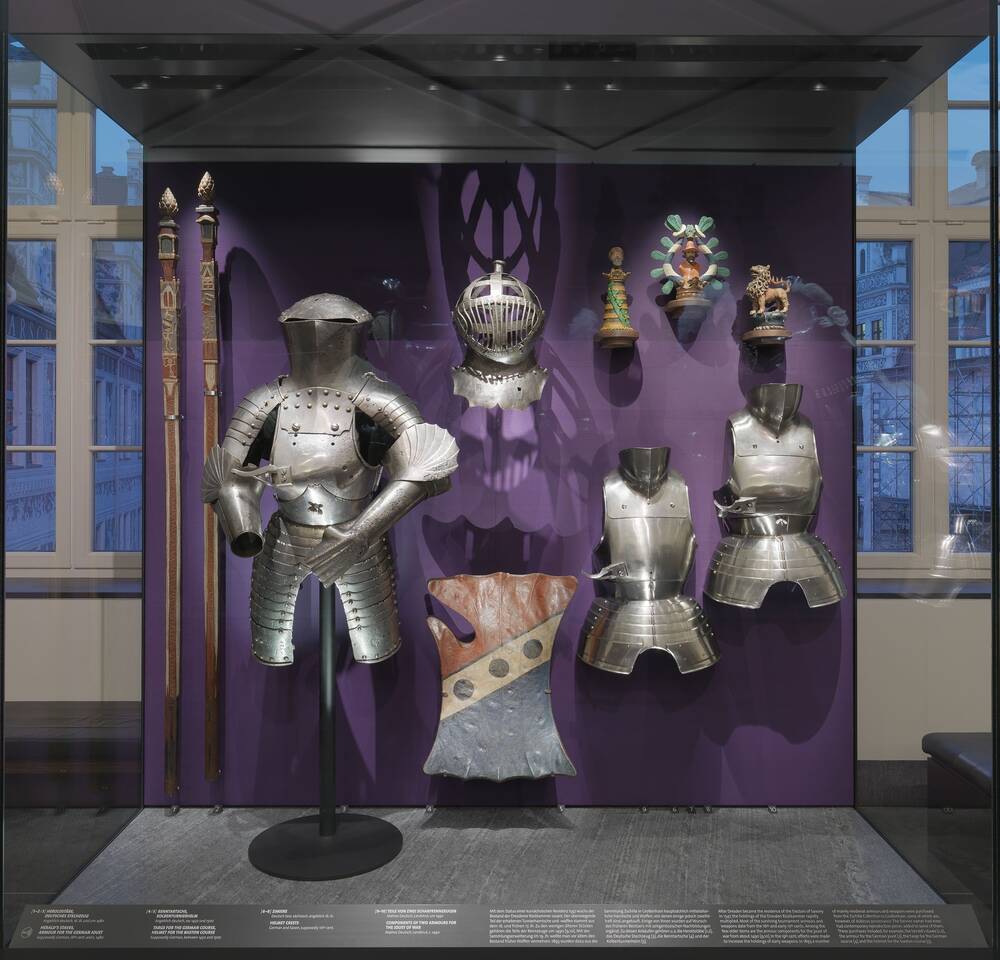“It is with a special affection and desire that we do collect and preserve in our armoury the suits of armour worn by our most esteemed forefathers and other relatives and good friends of our house in campaigns and battles that we hold in happy and eternal memory.”
This passage is from a letter written by the Austrian Archduke Ferdinand to the Prince-Elector August of Saxony in Dresden. Today it is in the State Archives of Saxony. Yet August might just as easily have written the same lines to another Ferdinand, brother to the Holy Roman Emperor Maximilian II. For August also collected his forefathers’ armour and weapons, including equipment and arms used in chivalric contests. The Rüstkammer inventory dated 1567, just a few years after Ferdinand’s letter to August, lists over fifteen hundred weapons. But not every item in the collection today belonged to those “most esteemed forefathers” – and some are not even as old as they may seem.
In the first display case on the left, you can see various items of tournament equipment from the Late Middle Ages – or, at least, purportedly from that period. The main items in the collection were made after 1547, when the Elector of Saxony chose Dresden as his residence. Some three hundred years later, in the nineteenth century, various museum directors tried to close the historical gaps in the collection regarding the period before 1547. As a result, some dubious items were purchased from other collections.
The jousting equipment made of wrought and chased iron, however, is definitely authentic; the pieces were made around 1490 to be used in Scharfrennen – “jousts of war” or German-style jousts. The authenticity of the other items is less certain, that’s to say, the decoratively painted crests, wooden figures, towers or caps for ornamenting the helmets of tournament knights; a helmet for the baston course; a very worn-looking German suit of armour for tilting; a special tournament shield, known as a targe, that was fastened onto the left side of the breastplate to protect a knight from the thrust of his opponent’s lance, and two carved and partly gilded herald’s staves.
Towards the end of the fifteenth century, the concept of the tournament changed. Originally, it had been a training ground for war, a chance for knights to practice and demonstrate their battle skills. With the advent of firearms, however, knights in armour disappeared from the theatre of war; it was no longer necessary to ride against the enemy with lances and swords, protected by iron plate. But the skills and the equipment were not lost. Tournaments now served as courtly entertainments and as displays of the Electors’ power and prestige.
If you would like to find out more, please listen to the audio under further media.
Further Media
Every collection is a reflection of its time. In the sixteenth and seventeenth centuries the Electors of Saxony wanted to preserve the memory of their forefathers. The nineteenth century aimed at comprehensiveness. Today, we do everything we can to present the contents of the collection as authentically as possible. This involves dating items, as far as possible, and establishing their provenance and how they were originally used. In exhibitions this information should be easily accessible to the layperson. But the huge number of objects in our collection means that only a historical and thematic selection can be shown at any one time in the Riesensaal.
The main focus of our presentation is the tournament. With a large number of display cases and life-size tableaux on the platforms, this topic takes up almost all the first half of the hall. The Peffenhauser armours in the middle of the hall form a link to the second half, which focuses on ceremonial armour. Peffenhauser was one of the most important armourers of the late-sixteenth century, and he produced numerous items for Dresden, including many tournament armours of the highest quality. In the second half of the hall you can see some of the ceremonial weapons and armours from the mid-sixteenth to the mid-seventeenth century that have been preserved here in Dresden – masterpieces of the very finest European craftsmanship.
Unlike other collections, in which splendid objects from past generations were presented in a conventional museum style, the Dresden Electoral Armoury was always a collection of items to be used. These objects were carried or worn in processions, festivals and parades. When those parades and processions died out, the interest in armours and weapons decreased. Porcelain and paintings now took pride of place. In the nineteenth century, the splendid armours of earlier generations were displayed as museum pieces. Contemporary items were no longer added, just the occasional acquisition to close a gap in the collection.
